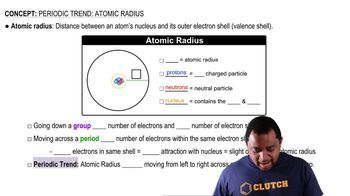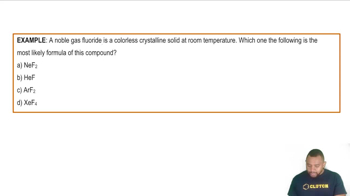(a) If the core electrons were totally effective at screening the valence electrons and the valence electrons provided no screening for each other, what would be the effective nuclear charge acting on the 3s and 3p valence electrons in P?
In Table 7.8, the bonding atomic radius of neon is listed as 0.58 Å, whereas that for xenon is listed as 1.40 Å. A classmate of yours states that the value for Xe is more realistic than the one for Ne. Is she correct? If so, what is the basis for her statement?
 Verified step by step guidance
Verified step by step guidance
Verified video answer for a similar problem:
Key Concepts
Atomic Radius

Noble Gases and Their Properties

Bonding vs. Non-bonding Atomic Radius

(b) Repeat these calculations using Slater’s rules.
(d) If you remove a single electron from a P atom, which orbital will it come from?
The As ¬ As bond length in elemental arsenic is 2.48 Å. The Cl ¬ Cl bond length in Cl2 is 1.99 Å. (a) Based on these data, what is the predicted As ¬ Cl bond length in arsenic trichlo- ride, AsCl3, in which each of the three Cl atoms is bonded to the As atom?
The following observations are made about two hypothetical elements A and B: The A—A and B—B bond lengths in the elemental forms of A and B are 2.36 and 1.94 Å, respectively. A and B react to form the binary compound AB2, which has a linear structure (that is, ∠B-A-B=180°). Based on these statements, predict the separation between the two B nuclei in a molecule of AB2.
The As ¬ As bond length in elemental arsenic is 2.48 Å. The Cl ¬ Cl bond length in Cl2 is 1.99 Å. (b) What bond length is predicted for AsCl3, using the atomic radii in Figure 7.7?
